One of my favorite herbs is St. John’s wort. When I was introduced to this medicinal wonder, I was immediately drawn to it. That biophilia happens with certain plants. You meet many, but may only make a deep connection with a few – kind of like with people. Before I tell you why I like St. John’s wort so much, let’s make sure we’re talking about the same plant.
One of the difficulties with learning herbs is their names: 1) multiple plants have the same name, 2) many plants have more than one name, depending on geographic location, what so-and-so told you, and other factors, and 3) not everyone knows the botanical name, which makes it harder to be certain you’re talking about the same plant.
The St. John’s wort that is commonly used medicinally is this one (Hypericum perforatum):
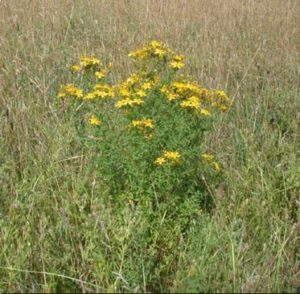
Not this one (Hypericum calycinum):
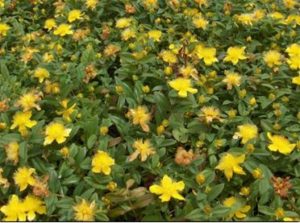
The two varieties look very similar. The obvious difference is SIZE. Hypericum perforatum grows 1 to 3 feet high, is narrow, and has flowers that are about a 1/2 inch wide. Hypericum calycinum is shrubbier, shorter, and has much larger flowers, up to 3 inches wide. H. perforatum is considered a weed, and H. calycinum a lovely ornamental ground cover. Like many “weeds”, H. perforatum is the medicinal one.
Here are some of the reasons why I think St. John’s wort is so cool:
1 – I like its name. It derives from the time of year that the plant is in flower. St. John’s wort blooms around the summer solstice (about June 21), also known as Midsummer Day in Europe. As Christianity spread, June 24 became a holiday honoring St. John the Baptist. Some herbalists refer to it as “St. Joan’s wort.” Originally, the word “wort” meant medicinal herb. So from its name alone, you can tell both when the plant blooms and that it’s used medicinally.
2 – I like that it looks perforated with little “holes” (actually oil glands) in its leaves and that its botanical species name (perforatum) reflects that characteristic.
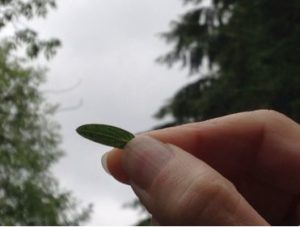
3 – I like that – similar to dandelion, plantain, and so many other powerful “weeds” – it can be found growing in less-than-optimal conditions, such as gravel and on the sides of roads. (You can even seeing them growing along the sides of freeways at this time of year!)
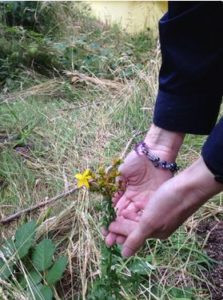
4 – I like that it defies conventional wisdom:
- Even though it has yellow flowers, its medicine (hypericin) is purple-red and will turn your tinctures and oils that same color!
-

If it’s medicinal, the crushed bud should stain your finger red - Blooming at the summer solstice, St. John’s wort has a true affinity for the sun. When I first started working with St. John’s wort, I made the mistake of placing the flower infusion along with other concoctions in my dark pantry. I wondered why it didn’t turn the same beautiful red color that my teacher’s did. Unlike most herbs that need to infuse in dark places like a root cellar or kitchen cabinet, St. John’s wort needs to infuse in the sun for at least four hours to fully extract the its medicinal properties.
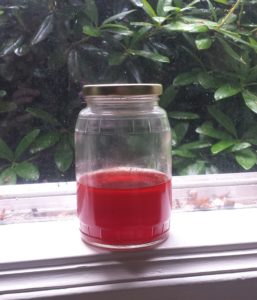
5 – I like that St. John’s Wort has so many uses:
- It is perhaps most well-known for its treatment of certain types of mild depression.
- It is a valuable ingredient in herbal healing salve.
- It has an affinity for the nervous system which means that it is effective for nerve pain.
- It is effective in treating cold sores, herpes and other viruses.
- In Traditional Chinese Medicine, St. John’s wort is used to treat liver stagnation and conditions associated with nervousness: chronic tension headaches, menopausal tension, and restless insomnia.1
An important note before ingesting St. John’s wort: Because of its ability to restore liver function, St. John’s wort can reduce the effectiveness of many pharmaceuticals, including antiarrhythmics, antidepressants, antivirals, antihistamines, and others:
“St. John’s Wort speeds up the CYP450 enzyme metabolism pathways in the liver. In fact, St. John’s Wort increases the effectiveness of liver metabolism so effectively that some pharmaceuticals are cleared from the liver before they have had a chance to work. While this has been used to vilify the use of herbs and drugs at the same time, it also shows how powerful this herb is for the liver.” – Rosalee de la Foret, HerbMentor
While St. John’s wort may be taken as a tea, I look forward to gathering the buds, flowers and some leaves to infuse in oil for healing salves. I also save some to prepare as a tincture (infused in alcohol or glycerin) for a client with intermittent facial pain (trigeminal neuralgia). A combination of the salve and tincture has been effective in pain reduction without using other medication.
1Tierra, L. Healing with the Herbs of Life, Crossing Press, 2003.

Can either of the two St Johns wort be used for medicine? I have Hypericum calycinum growing in my yard. Do they have the same hypericum that is medicinal? I have heard the berries are toxic. Can you share with me if this is the case?
Thank you,
Katrina
Hi Katrina – Thanks for your question! Hypericum calycinum does not have the same medicinal properties as Hypericum perforatum. (An easy way to check if you’re unsure is to crush the flower between your fingers. If it turns red, it contains medicinal properties.) I’m not familiar with the cultivated variety, so unfortunately can’t answer your question about their berries. Best – Kim